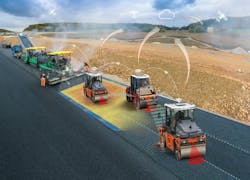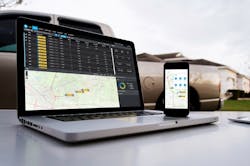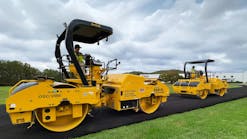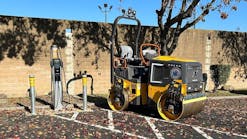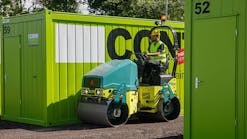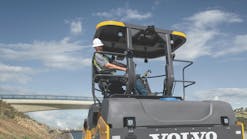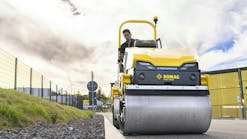Telematics Start Roadbuilding Machines Talking
Not to be outdone by telematics advances in earthmoving equipment, paving equipment OEMs—and familiar technology companies such as Topcon and Trimble—have introduced systems with increasing levels of sophistication.
The technology is advancing beyond GPS and stringless paving for concrete paving operations, 2D and 3D systems for asphalt paving, and intelligent compaction-measurement systems. As a result, managers have a number of interesting choices to manage the entire paving process or its various aspects.
Here is an overview of just some of the more recent technologies that enable a march toward greater efficiency in asphalt pavements. It starts with the more process-oriented systems.
Introduced in April during Bauma in Munich, Germany, Topcon’s Pavelink is a cloud-based logistics application designed to connect each stakeholder in real-time throughout the paving process. The mobile application is designed to complete a “connected ecosystem” workflow between the asphalt plants, delivery trucks, company office, and paving site.
The software is made to integrate with existing planning and management tools to improve and advance efficiency, minimizing issues such as overages or potential paver stoppages by addressing them more quickly, or before they arise.
“Pavelink is a way to plan and manage the asphalt paving process with real-time visibility throughout the project lifecycle,” says Murray Lodge, senior VP of construction for Topcon. “The system automatically gathers and centralizes all relevant information such as quantities, temperatures, number of trucks loaded, current truck locations, job-site arrival estimations, number of trucks returning or queuing for more loads, current screed width, current paver speed, and amount of roadway that has been laid.
“The entire team can be reached in an instant with smooth communication,” Lodge says. “If the mix needs to be adjusted, for example, the field crew can easily signal the asphalt plant. They can also ask to expedite material and send more, or fewer, loads. The home office has access to the real-time data, facilitating assistance with daily job management.”
The system automatically generates digital weigh tickets at the plant that are delivered to the truck driver’s loaded app, as well as uses geofence recognition of the arrival of a haul truck at the job site, and tracks all activity digitally—designed to simplify the reporting and documentation process.
“This logistics application is the newest piece of the Topcon end-to-end paving solution offering,” Lodge says. “It pairs perfectly with existing Topcon solutions such as SmoothRide—using the analysis and design data generated, Pavelink then manages the material that is needed as it delivered to the site. Pavelink continues to provide logistics information as the pavers use the SmoothRide system for road resurfacing.”
Vögele, the paver brand of the Wirtgen Group, has updated its software-based process-management solution, WITOS Paving. Previously, Vögele had offered contractors two options for recording and evaluating job-site data: the RoadScan non-contacting temperature-measurement system, with which the site manager can monitor the paving temperature; and the WITOS Paving Plus telematics solution, which coordinates and optimizes all processes from mixing plant to paving, in real time.
The latest feature, WITOS Paving Docu, has been specially developed for contractors who want to record and evaluate other data in addition to the paving temperature, but who do not need the full range of WITOS Paving Plus functions that include process optimization.
With WITOS Paving Docu and the help of an app, site managers can initiate jobs directly on the job site without prior planning, recording all the paver and paving data. In addition, delivery notes can be scanned-in using a QR code or also entered manually, and, at the end of the day’s paving operations, automated job-site reports can be sent to selected recipients. The app and pavers are networked via WLAN, so that information can be exchanged even without a mobile phone connection.
Roadtec says its Guardian Telematics is the only telematics system that allows live, two-way wireless communication between paving machines and remote devices. “The Guardian technology is designed to increase efficiency and limit downtime, which contributes to our customers’ success,” says Eric Baker, director of marketing and sales support.
Guardian delivers its real-time reporting via a cellular signal. Owners and service technicians can monitor electrical and hydraulic systems, grade/slope control, the machine’s speed, location, engine, load, and fuel usage, and receive fault codes, service reminders, and production reports. Roadtec technicians can be contacted in the event of a problem, and will remotely access the machine for electronic troubleshooting and diagnosis.
Caterpillar offers the Cat Compaction Control suite of technologies, which encompasses its version of intelligent compaction, as well as additional features.
The Cat technologies are designed to answer contractor questions about the correct number of passes, any missing segments, and the mat temperatures required for continued compaction. Through the use of machine-to machine communication, compactors can share information with each other.
Options are available for asphalt compactors to help operators maintain uniform rolling patterns. Screens in the operator’s compartment can be programmed to show the operator where the roller is located on the mat and how much of the pattern has been completed.
GPS systems provide accurate maps of rolling patterns. The control can be programmed with the required number of passes. Then, the screen will display different colors as the passes are completed. The operator no longer has to guess at the end of the pattern for reversing. And, there is less chance that the operator will miss any of the areas in the pattern because the screen provides immediate feedback for quick corrective action, Cat says.
For temperature management, dual infrared temperature sensors mounted on the front and rear of the machine deliver real-time temperature readings. The sensors are continually cleaned by compressed air that keeps dust, fumes, and moisture away from the sensor lenses.
The temperature system provides constant, visual reference at the operator’s station display. Not only does the operator know where the machine is located in relation to the defined rolling pattern, the operator knows where the machine is located relative to the desired temperature zone. Temperature Mapping provides a visual readout of mat temperature in order to keep the machine in the proper temperature range, informing the operator when to begin rolling and when to stop.
The Machine-to-Machine Communication system also assists in keeping rolling patterns coordinated by sharing coverage and pass-count maps via the operating displays of multiple machines. By viewing the color display, operators can monitor areas of coverage and the number of passes made. If a trailing operator identifies an area of missed coverage, the deficiency can be immediately corrected to ensure consistent coverage. The system facilitates echelon compaction when multiple machines are executing rolling patterns.
This technology is especially helpful during nighttime operation when it is difficult to see where the compactor has been, according to Caterpillar. Real-time visual references for passes made and mat temperatures reduces inconsistencies in the rolling pattern. Without the system, operators might question the stopping point on a previous pass or return pass, whether pass overlap was sufficient, or whether mat temperature was in the proper range.
Trimble’s premium system, the CCS900 Compaction Control System, also allows data sharing between compactors in real-time. Basic pass-count mapping allows users to monitor the number of passes over an area to adjust efforts to avoid over- or under-compaction. The wireless data share allows each compactor to see the work being done by other compactors in real time for achieving consistency, reducing improper compaction, improving surface quality, and saving time and fuel.
The company says its wiring harnesses are permanently installed for optimal fit and integration with the machine body, and the system works with its Connected Site concept in concert with Cat’s VisionLink System so compaction data can be transferred to the office for analysis.
BOMAG’s Economizer compaction measurement system delivers real-time compaction progress on the control panel’s LCD display. As material stiffness increases, more lights illuminate in the display to let the operator know when optimum compaction is achieved and prevent fracturing the aggregate in the mix. Economizer saves contractors time, money, and fuel by eliminating unnecessary passes and allowing for the correction of “soft” spots in the mat, the company says.
The Asphalt Manager intelligent compaction management system features vectoring drum vibration from true vertical to true horizontal, BOMAG says. With a goal of helping the novice operator achieve the same compaction results as a seasoned veteran, Asphalt Manager’s operation requires that only the asphalt lift thickness to be entered. Vibration direction and compaction force is automatically controlled, based on material stiffness and temperature. Asphalt Manager automatically matches vibration direction to the roller’s travel direction, preventing ripples in the mat.
For contractors who need to provide complete documentation of job-site compaction, the available BOMAG Compaction Management system generates continuous compaction charts in real-time using GPS data to increase mat quality. For contractors already using a mapping system, the BOMAG intelligent compaction (IC) interface is designed for third-party mapping system integration, since the IC interface allows the third-party system to tap into the roller’s onboard sensors and machine data, eliminating the time and cost required for third-party sensors to be installed.
